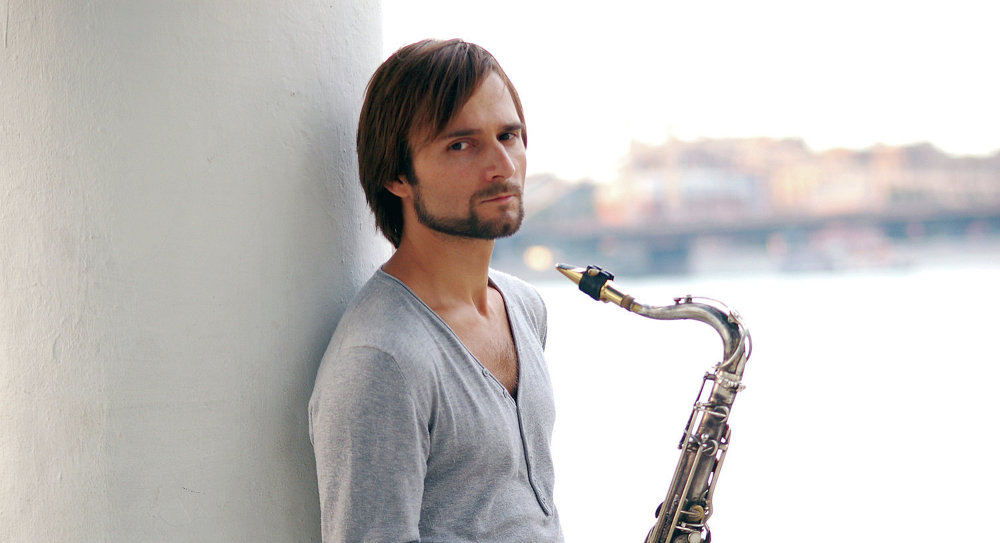— How did you first learn about jazz?
— As a child, my father gave me a saxophone. It was all so shiny, with buttons.
We had at home many Soviet-made jazz records that you could buy cheap at a consignment store. We had a decent collection, I must say. I remember my first impressions. There were a few records that I could understand, among them the Bag's Groove by Miles Davis, a record featuring top saxophonist tenors and Bill Evans Trio. Such a hodge podge…
My parents supported my interest and suggested things that I should see and listen to. They said the saxophone was a symbol of freedom and all that, and I tried to play tunes on the saxophone by ear. Back then, I studied clarinet at a musical school and tried to figure out how to play these unusual sounds. This is how it started.
I remember I was surprised how different jazz can be: music by Bill Evans' trio sounded magical, mysterious and cold to me, while music by Sonny Rollins and Monk was hot and groovy. Back then, I realized that jazz can be very different and suit every taste out there.
Musicians don't divide music into different styles. They often say that they play what they want, and critics then come with classifications, divisions and styles.
— What is your preferred music style?
— I'm a saxophonist and I had a preference for traditional jazz where the saxophone plays an important role from day one. While I practiced on my own, it was more of a traditional jazz, swing and, probably, bebop, something in the spirit of Dexter Gordon and Sonny Rollins.
Then I was lucky enough to study at the Gnessin Russian Academy of Music with Professor Alexander Oseichuk, who has a clear idea of what a saxophonist should be like, what he should be able to do and what material and technical means of expression he must know to be able to easily and professionally navigate all genres and styles.
That's how my training went: first, there was the children's love for traditional jazz, which was close to me. After I gained certain improvisation skills, my tone abilities began to improve, and I began to understand other styles and dig deeper. Then I realized that jazz comes in many genres (not just swing and bebop). Then I discovered the European contemporary music (ECM).
Now, I pursue several projects, and one of them — Arimoya Band — is the ECM style. This style has been developing in Europe alongside the development of jazz in America. It has its own unique colors thanks to the people who were able to articulate their feelings about jazz in their own way and created this wonderful ECM style. I believe Alex Rostotsky is an adept who promotes this music in Russia, and I was fortunate enough to work with him. He has been working in the ECM style for a long time and has been releasing exceptionally good records since the1980s.
— Which musicians are better?
— Americans are better at American jazz because their technology, schools, festivals and clubs are cut out specifically for this kind of music. Europe has its own music, its own jazz, audiences, and they love their musicians.
We in Russia have original musicians, some went to Berkley, which many American stars are graduates of. Some returned to Moscow and created their own successful projects. They bring foreign musicians to Russia and go to the United States to make their own records.
— Would you like to see how you stack up against the Western musicians?
— Actually, it's more fun for the audiences than the musicians themselves. Musicians never compete; it's bad manners.
The whole thing started back when a musician would play some amazing passage to please the crowd, or they arranged orchestra contests. Today, this may happen at a jam session, but it is not an end in itself, although it may be seen that way. Still, the most important thing is to show your ideas. I, for one, am always ready to perform with any musician. The stronger and more interesting he is, the better.
Today's music industry doesn't cut anyone any slack because times are changing and people have other ways to entertain themselves. Music and concerts are not as popular as before. There is a general decline in Russia and the West. But this doesn't stop anyone, as in jazz everything builds on love, passion and the desire to be part of this music.
— What do you know about the Koktebel Jazz Party?
— I've heard quite a lot about it from my friends who went there. I know that you bring stars from Europe, Asia and America. Any musician would be honored to perform at a festival of such a level.
— Which musicians, living or dead, would you like to play with?
— That would be all the major figures who influenced jazz. Each can make you lose your head. Charlie Parker, John Coltrane, Miles Davis, Thelonious Monk, Jaco Pastorius, Herbie Hancock and Pat Metheny are the first who come to mind. They all have a divine spark, and they looked at the world without any limitations or fears. Each was determined to do something interesting. They are geniuses.
I was fortunate to have worked alongside some of my idols, such as legendary musicians Paco Sery and Linley Marthe from Joe Zawinul's group. We recorded Alex Rostotsky's disk with them.
It so happens that one fine day you may find yourself next to the people that you've heard on a record, and it's just some kind of magic!
